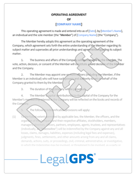Why Data Privacy is Crucial for HR Success
In today’s digital age, human resource (HR) departments handle an enormous amount of sensitive employee data, from personal information and health...
7 min read
LegalGPS : Oct. 16, 2024
As an e-commerce business owner, protecting your shoppers' privacy should be at the top of your priority list. Not only is it an essential way to build customer trust, but it also fulfills your legal obligations. One of the best ways to achieve both goals is by implementing a well-crafted e-commerce privacy statement. This key document tells users exactly what kind of personal data you collect, how you use it, the steps you take to protect it, and more.
If writing a privacy statement feels overwhelming, don't worry. This guide will break down the process step-by-step, making it approachable even if you're not a legal expert.


Legal GPS Pro
Protect your business with our complete legal subscription service, designed by top startup attorneys.
An e-commerce privacy statement is essentially your handshake agreement with shoppers. It clearly explains how you treat customer data on your e-commerce platform. In many jurisdictions, having a privacy statement on your website is not just a suggestion but a legal requirement.
The goal? To foster transparency and build trust with your customers while staying compliant with regulations like the GDPR (General Data Protection Regulation) or California's CCPA (California Consumer Privacy Act).
Your privacy statement should be tailored to reflect your specific business practices. However, there are several core components that every e-commerce privacy statement should cover:
Outline the types of data you collect. This might include names, email addresses, payment information, IP addresses, or browsing activity.
Sample Clause: "We collect various types of information in connection with the services we provide, including:
Personal identification information (e.g., name, email address, phone number)
Payment details (e.g., credit card information, billing address)
Technical data (e.g., IP address, browser type, operating system)
Usage data (e.g., browsing history, search queries)"
Explain how you use this data. For example, it could be for processing orders, offering customer support, sending marketing communications, or conducting analyses to improve your services.
Sample Clause: "We use the information we collect for the following purposes:
To process and fulfill your orders
To communicate with you regarding your purchases or inquiries
To send promotional offers and marketing communications (with your consent)
To improve our services and enhance user experience"
Customers want to know their data is secure. Detail how you store their information, such as using encryption or secure servers.
Sample Clause: "We implement appropriate technical and organizational security measures to protect your personal data. These measures include:
Data encryption during transmission and storage
Secure servers protected by firewalls
Regular security audits and vulnerability assessments"
If you share customer data with third parties (e.g., payment processors, marketing agencies), disclose it. Let shoppers know who you share their data with and why.
Sample Clause: "We may share your personal information with trusted third parties, including:
Payment processors to facilitate transactions
Shipping companies to deliver your orders
Marketing partners to assist with promotional activities These third parties are obligated to protect your data and use it solely for the purposes specified."
Describe the tracking tools you use, such as cookies or pixels, and explain why you use them.
Sample Clause: "We use cookies and similar tracking technologies to enhance your browsing experience. Cookies help us:
Remember your preferences and settings
Understand how you interact with our website
Deliver targeted advertising based on your browsing activity You can manage your cookie preferences through your browser settings."
Inform users of their rights, such as how they can opt-out of data collection, request data deletion, or correct inaccuracies.
Sample Clause: "You have the following rights regarding your personal data:
Access: Request a copy of the personal data we hold about you
Correction: Request corrections to any inaccuracies in your data
Deletion: Request the deletion of your personal data under certain circumstances
Objection: Object to the processing of your personal data for marketing purposes To exercise any of these rights, please contact us at [contact information]."
Implement strong data security measures
A generic template won't be sufficient—your privacy statement needs to reflect your unique data practices. Here’s a step-by-step guide to creating a privacy statement that will safeguard your business and reassure your customers.
Begin by conducting a thorough audit of your data practices. Identify every type of personal data you collect, how you collect it, where you store it, and what you use it for. This step is critical for ensuring you have a comprehensive understanding of your data practices before drafting the privacy statement.
What data you collect: List all personal data collected (e.g., name, email, payment information, IP address, browsing activity).
How you collect it: Identify the methods used to collect data (e.g., forms, cookies, third-party tools).
How you use it: Specify how each type of data is used (e.g., processing orders, offering customer support, marketing, product improvements).
Create a detailed inventory of all the data points, along with their purposes. This will serve as the foundation for drafting an accurate and transparent privacy statement.
A well-organized privacy statement is easier for your customers to understand and navigate. Structure it into clearly defined sections:
Introduction: Briefly describe your commitment to protecting privacy and explain why the privacy statement is important.
Information Collected: Detail every type of data you collect, along with specific examples to make it relatable for users.
Usage of Collected Information: Explain in clear terms how you use each type of data. Be specific about the purposes, such as processing payments, offering customer support, or sending promotions.
Data Storage and Security: Outline the steps you take to protect data, including encryption, secure servers, and access restrictions.
Third-Party Sharing and Usage: Disclose any third parties you share data with and why. Include a list of key partners, such as payment processors, and explain what data is shared.
Cookies and Tracking Technologies: Describe the tracking technologies you use, why you use them, and how users can manage their preferences.
Customers' Rights and Choices: Clearly explain user rights, including opting out of data collection, accessing their data, and requesting data deletion.
With your structure and data inventory ready, start drafting your privacy statement. Use direct and accessible language. Remember, the goal is to make it easy for users to understand what happens with their data.
Introduction: Reassure customers of your dedication to safeguarding their data.
Sample Clause: "We value your privacy and are committed to protecting your personal information. This Privacy Statement explains how we collect, use, and share your data, as well as the steps we take to safeguard it."
Information Collected: List all types of data in bullet points for clarity.
Sample Clause: "We collect a variety of information to provide our services, including:
Personal information such as your name, email address, and phone number.
Financial information such as payment details and billing address.
Technical information, including IP address and browser type.
Usage data, like browsing activity and search queries."


Legal GPS Pro
Protect your business with our complete legal subscription service, designed by top startup attorneys.
Usage of Collected Information: Describe each use of data in a simple and transparent way.
Sample Clause: "We use your data to:
Process and fulfill your orders, including delivery and payment verification.
Communicate with you about your purchases, respond to inquiries, and provide support.
Send marketing communications that we believe may be of interest to you, with your consent.
Improve our services and personalize your experience on our website."
Data Storage and Security: Specify the measures you take to ensure data security, such as encryption and regular backups.
Sample Clause: "We take data security seriously and implement industry-standard measures to protect your information:
We encrypt sensitive information both during transmission and when stored.
Our servers are protected by firewalls and monitored for suspicious activity.
We conduct regular security assessments and staff training to stay ahead of potential risks."
Third-Party Sharing: Be upfront about the third parties involved, their role, and the data they receive.
Sample Clause: "We may share your information with:
Payment processors to handle transactions securely.
Shipping carriers to deliver your orders.
Marketing agencies to help us provide tailored offers and promotions. All third parties are contractually obligated to protect your data and can only use it for the services they provide to us."
Cookies and Tracking Technologies: Provide examples of cookies and tracking technologies, and include instructions on how users can manage their preferences.
Sample Clause: "We use cookies to enhance your experience by:
Remembering your preferences, such as language settings.
Providing personalized product recommendations based on your browsing history.
Delivering targeted advertising tailored to your interests. You can manage or disable cookies through your browser settings; however, doing so may affect your ability to use some features of our site."
Customer Rights: Clearly outline how users can exercise their rights, such as contacting you to delete or update their information.
Sample Clause: "You have the right to:
Access: Request a copy of the personal data we hold about you.
Correction: Correct any errors or inaccuracies in your personal information.
Deletion: Request the deletion of your personal data when it is no longer needed.
Restriction: Limit the processing of your data in specific situations. To exercise these rights, please contact us at [contact information]. We will respond within 30 days."
Ensure that your privacy statement complies with all relevant privacy laws and regulations, such as GDPR or CCPA. Consider consulting a legal expert to review the document, or use a trusted legal guidance tool to identify any gaps.
Examples of Compliance: Include clauses that show your compliance with specific regulations, such as data processing agreements or user consent management.
Sample Clause for GDPR Compliance: "In compliance with the GDPR, we ensure that:
Personal data is processed lawfully, fairly, and transparently.
Data is collected for specified, legitimate purposes and not further processed in a manner incompatible with those purposes.
We implement appropriate security measures to protect personal data against unauthorized access, alteration, or deletion."
A privacy statement should be easy to read and accessible to all users. Format the document to be scannable, with bullet points, headings, and short paragraphs.
Use Headings and Subheadings: Break the privacy statement into logical sections for easy navigation.
Bullet Points for Clarity: Use bullet points to list types of data, rights, and third-party sharing.
Accessible Language: Avoid legal jargon and use simple terms that customers will easily understand.
Before making your privacy statement live, test it with a few users to gather feedback on clarity and accessibility. Make any necessary adjustments based on their feedback.
Placement on Website: Ensure the privacy statement is easy to find by linking to it in your website footer, during user sign-up, and on checkout pages.
Privacy regulations and data practices can evolve, so your privacy statement should, too. Establish a schedule to review your privacy policy at least annually or whenever significant changes occur in your data practices.
Update Notifications: When updates are made, notify your users via email or through a pop-up on your website, and clearly mark the "Last Updated" date at the top of the privacy statement.
Sample Clause: "We may update our Privacy Statement from time to time to reflect changes in our practices or legal requirements. When we make significant changes, we will notify you by email or through a prominent notice on our website. The 'Last Updated' date at the top of this policy indicates the latest revision date."
While a custom privacy statement is best, using a template as a starting point can save time, especially for small businesses. Our Legal GPS privacy statement template is professionally crafted to provide a solid foundation for your business's privacy needs.
A transparent and well-crafted e-commerce privacy statement not only keeps you compliant but also builds trust—and in e-commerce, trust is crucial for converting shoppers into customers.
The biggest question now is, "Do I need a business lawyer?” For most businesses and in most cases, you don't need a lawyer to start your business. Instead, many business owners rely on Legal GPS Pro to help with legal issues.
Legal GPS Pro is your All-In-One Legal Toolkit for Businesses. Developed by top startup attorneys, Pro gives you access to 100+ expertly crafted templates including operating agreements, NDAs, and service agreements, and an interactive platform. All designed to protect your company and set it up for lasting success.

Legal GPS Pro
Protect your business with our complete legal subscription service, designed by top startup attorneys.

100+ legal templates, guides, and expert advice to protect your business.
Trusted by 1000+ businesses
Table of Contents

In today’s digital age, human resource (HR) departments handle an enormous amount of sensitive employee data, from personal information and health...

Capturing website visitor information has become a common practice, but it comes with significant legal responsibilities. Over the years, “data...

Blogging has become a popular way to share information, build communities, and even generate income. However, the nature of blogs being publicly...